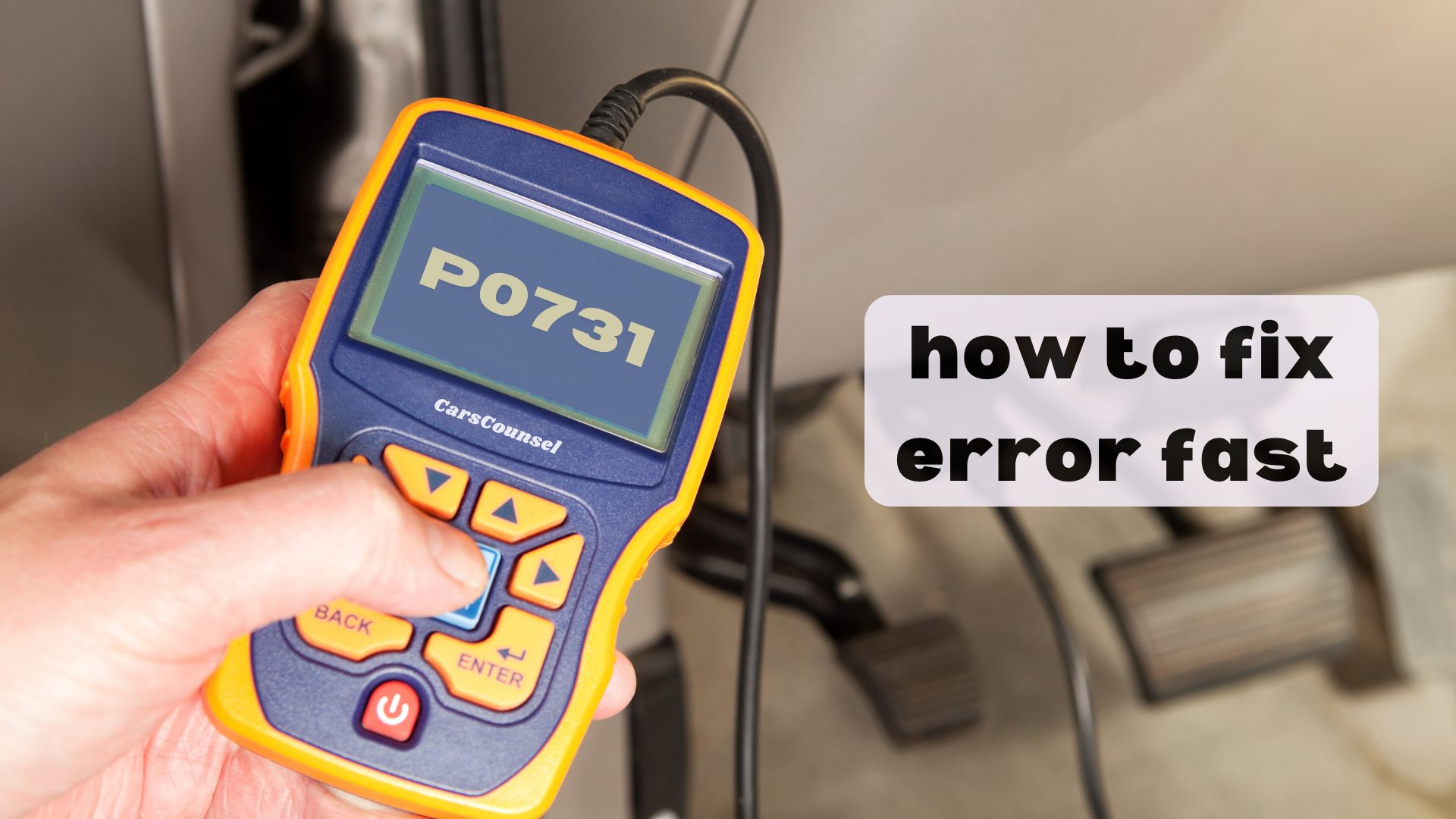Dealing with a P0731 code can be frustrating, but fixing it quickly is important to prevent more transmission problems.
First, confirm the error with an OBD-II scanner and look for any other OBD2 Codes.
Next, check the transmission fluid to make sure it’s at the right level and in good condition.
Also, inspect the transmission control module and shift solenoids for any visible damage or issues.
Want to know what to do next to solve this problem? There are more steps to follow to make sure your transmission works smoothly again.

Quick Navigation
Key Takeaways
- Use a car code reader to find out exactly what’s causing the P0731 error.
- Check the transmission fluid and add more if it’s low or replace it if it’s dirty.
- Look at the shift solenoids to make sure they’re working right and replace them if they’re broken.
- Check the Transmission Control Module (TCM) for any damage and either recalibrate it or replace it if needed.
What Is the P0731 Code?
The P0731 code means your car’s automatic transmission is having trouble shifting into first gear.
This code points to a problem within the transmission control system, which might cause issues with gear changes. If you see a P0731 code, it means your transmission is struggling to engage first gear properly, which can lead to bigger transmission problems.
The causes can include low transmission fluid, faulty shift solenoids, or a malfunctioning transmission control module (TCM).
Understanding this code is important for fixing the issue and getting your transmission back to normal, which can help prevent more serious damage in the future.
Symptoms of P0731 Code
You’ll often notice poor acceleration and lower gas mileage as main signs of the P0731 code. These problems usually happen because the gears aren’t working right, so it’s important to fix them quickly.
You might find it hard to get into first gear, and the car might shift gears roughly. Sometimes, the car might slip out of gear or take a while to go into first gear.
Taking care of your transmission can stop these problems from getting worse. Regular maintenance, like checking fluid levels and looking at parts, is key for smooth gear changes.
If you see these signs, don’t ignore them. Catching and fixing the issue early can save you from bigger transmission problems later.
Causes of P0731 Code
Several things can cause the P0731 code, and knowing them is essential for proper diagnosis and repair.
Low transmission fluid is a common cause and is often missed because people think the fluid lasts forever.
A bad shift solenoid can mess up gear shifts, leading to erratic behavior.
The transmission control module (TCM) might have issues, which can affect how accurately the car shifts gears.
Worn-out clutch plates or bands can make the transmission slip, making the problem worse.
Electrical issues, like faulty wiring, can also affect the transmission’s performance.
Ignoring these problems can lead to severe long-term damage and increased repair costs.
Fixing these issues quickly ensures your vehicle’s transmission stays in good shape.
Diagnosing P0731 Code
When diagnosing the P0731 code, start by using an OBD-II scanner to get and analyze the error codes.
Next, do a thorough visual check of your transmission parts. Look at the transmission fluid level and its condition; low or dirty fluid can cause shifting problems.
Use diagnostic tools to check how well the transmission control module (TCM) is working and test the shift solenoids for any faults.
Don’t ignore the wiring—look for any electrical issues that might affect transmission performance.
Good transmission maintenance means finding and fixing these issues quickly to prevent more damage and ensure smooth gear changes.
This step-by-step approach will help you find and fix the root cause of the P0731 code efficiently.
Using an OBD-II Scanner
Using an OBD-II scanner helps you find and understand error codes, which is a key first step in figuring out the P0731 code. The benefits of using an OBD-II scanner include locating the exact problem, saving time, and avoiding unnecessary repairs. There are different types of scanners, from simple code readers to more advanced diagnostic tools.
| Emotions | Impact |
|---|---|
| Frustration | Misdiagnosing without OBD |
| Relief | Accurate problem detection |
| Confidence | Using the right scanner |
| Satisfaction | Faster repair process |
| Trust | Dependable diagnostics |
Here’s what to do: connect the scanner to your car’s OBD-II port, get the trouble codes, and look at the data. This will help you find out what’s causing the P0731 code and decide on the needed repairs.
Checking Transmission Fluid
Checking the transmission fluid is an important step in diagnosing and fixing the P0731 code.
First, find the transmission dipstick, which is usually near the engine. With the engine warm and running, pull out the dipstick and wipe it clean. Put it back in, then pull it out again to check the fluid level. It should be between the ‘Full’ and ‘Add’ marks.
Look at the fluid quality; it should be bright red and free of debris. If it’s dark or smells burnt, change it right away.
Regularly checking your transmission fluid helps ensure your transmission works well and can prevent the P0731 code from coming back. Keeping an eye on fluid quality is crucial for top transmission performance.
Inspecting the TCM
After checking the transmission fluid, the next step is to look at the Transmission Control Module (TCM) to see if there are any problems that could cause the P0731 code. Start by finding the TCM and checking for any obvious damage or loose connections. Use a diagnostic tool to see if the TCM is talking correctly with the transmission system. If you find any problems, you might need to replace the TCM or recalibrate it to get everything working right.
Here’s a quick reference table:
| Step | Action | Tool Needed |
|---|---|---|
| 1 | Find the TCM | Screwdriver |
| 2 | Check connections | Your eyes |
| 3 | Test functionality | Diagnostic tool |
| 4 | Replace TCM | New TCM unit |
| 5 | Calibrate TCM | Calibration software |
Making sure you diagnose accurately ensures you fix the main problem.
Testing Shift Solenoids
To ensure your transmission shifts properly, start by checking the shift solenoids. Here’s how you can do it:
- Identify Shift Solenoid Types: Look at your vehicle’s manual to find out which solenoids are used in your transmission system. There are usually two types: on/off and variable force solenoids.
- Perform Electrical Tests: Use a multimeter to measure the solenoid’s resistance and compare it to what the manufacturer says it should be. If the resistance is off, the solenoid might be faulty.
- Conduct Mechanical Tests: Apply direct voltage to the solenoid to see if it turns on and off correctly. Listen for a clicking sound, which means it’s working properly.
Repairing Wiring Issues
After testing the shift solenoids, check the wiring for any wear, corrosion, or loose connections that could affect the transmission.
Carefully inspect all the wiring related to the transmission. Look for frayed wires, loose connections, or signs of rust. Use electrical tools to test the wiring’s continuity and resistance. If you find any damaged wires, replace or re-solder them.
Make sure all connections are tight and properly insulated. Also, check if any connectors are faulty and need replacement.
Fixing these problems will ensure the transmission control signals are sent correctly, helping to resolve the P0731 code effectively.
Preventing P0731 Code
Preventing P0731 Code
Taking care of your car’s transmission is crucial to avoid the P0731 code. Here are some simple steps to keep your transmission in good shape:
- Transmission Maintenance: Get regular check-ups for your transmission. This helps ensure all parts are working properly.
- Fluid Quality: Frequently check and change the transmission fluid. Using good quality fluid helps reduce friction and prevents overheating, which can lead to shifting problems.
- Early Detection: Use an OBD-II scanner now and then to spot any potential issues early. Catching problems early can save you from expensive repairs and keep your transmission running smoothly.
More OBD-II Codes
Frequently Asked Questions
How Much Does It Typically Cost to Fix a P0731 Code?
Fixing a P0731 code usually costs between $150 and $1,000. The cost depends on the specific problem, with diagnostic fees ranging from $50 to $150. Getting an accurate diagnosis is crucial for making sure the repairs are done right and efficiently.
Can I Drive My Car With a P0731 Code?
You shouldn’t drive your car if it has a P0731 code, which points to transmission problems. Use diagnostic tools to find the problem and fix it quickly. Ignoring it could cause serious damage to your transmission and make repairs more expensive.
How Long Does It Take to Repair a Transmission Issue Causing P0731?
Fixing a transmission issue that causes a P0731 code can take anywhere from a few hours to a full day. The exact time depends on how complicated the problem is and whether the necessary parts are readily available.
Are There Any Temporary Fixes for the P0731 Code?
Think of it like a quick patch: check and add more transmission fluid as a short-term fix. Use diagnostic tools to find the problem, but keep in mind that these quick fixes won’t replace professional repairs for a permanent solution.
What Are the Long-Term Effects of Ignoring the P0731 Code?
Ignoring the P0731 code leads to transmission wear and breakdown of the transmission fluid. You’ll experience worsening gear shifts, possible transmission failure, and expensive repairs. Fix it quickly to keep your car safe and running well. Regular maintenance can help avoid these problems.
Conclusion
Think of your car’s transmission like a band. If one member, like the Transmission Control Module (TCM) or a shift solenoid, is out of sync, it messes up the whole performance.
By quickly diagnosing the P0731 code with an OBD-II scanner and checking fluid levels, wiring, and damaged parts, you can get everything back in order.
Staying on top of these details ensures your transmission works smoothly, keeping your car running well.

